Oncogene-induced senescence and tumour control in complex biological systems
- PMID: 29666473
- PMCID: PMC5988800
- DOI: 10.1038/s41418-018-0102-y
Oncogene-induced senescence and tumour control in complex biological systems
Conflict of interest statement
The authors declare that they have no conflict of interest.
Figures

Comment on
-
Pharmacological activation of REV-ERBs is lethal in cancer and oncogene-induced senescence.Nature. 2018 Jan 18;553(7688):351-355. doi: 10.1038/nature25170. Epub 2018 Jan 10. Nature. 2018. PMID: 29320480 Free PMC article.
References
-
- Demaria M, et al. Cellular senescence promotes adverse effects of chemotherapy and cancer relapse. Cancer Discov. 2017;7:165–76. doi: 10.1158/2159-8290.CD-16-0241. - DOI - PMC - PubMed
Publication types
MeSH terms
LinkOut - more resources
Full Text Sources
Other Literature Sources

